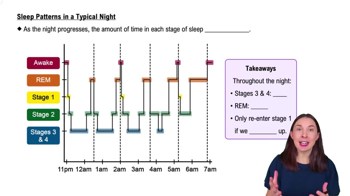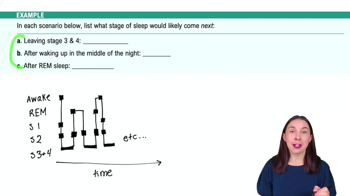Table of contents
- 1. Introduction to Psychology1h 43m
- 2. Psychology Research2h 20m
- 3. Biological Psychology2h 41m
- 4. Sensation and Perception28m
- 5. Consciousness and Sleep32m
- 6. Learning41m
- 7. Memory34m
- 8. Cognition37m
- 9. Emotion and Motivation35m
- 10. Developmental Psychology33m
- 11. Personality48m
- 12. Social Psychology41m
- 13. Stress and Health41m
- 14. Psychological Disorders44m
- 15. Treatment47m
5. Consciousness and Sleep
Sleep
Struggling with Psychology?
Join thousands of students who trust us to help them ace their exams!Watch the first videoMultiple Choice
Driving and talking on a cell phone at the same time is an example of a state of
A
waking consciousness.
B
increased alertness.
C
meditation.
D
divided consciousness.
 Verified step by step guidance
Verified step by step guidance1
Identify the key terms in the problem: 'driving', 'talking on a cell phone', and 'state of consciousness'.
Understand the concept of 'divided consciousness', which refers to the ability to perform multiple tasks simultaneously, often leading to a split in attention.
Consider how driving and talking on a cell phone require attention to be divided between two tasks, which fits the definition of divided consciousness.
Compare the other options: 'waking consciousness' is a general state of being awake and aware, 'increased alertness' suggests heightened focus, and 'meditation' involves focused relaxation, none of which describe performing two tasks at once.
Conclude that the scenario of driving and talking on a cell phone best aligns with the concept of divided consciousness, as it involves multitasking and splitting attention.

 3:25m
3:25mWatch next
Master Circadian Rhythms with a bite sized video explanation from Hannah Gordils
Start learningRelated Videos
Related Practice


































































































![Race, Genes and IQ Differences | Bret Weinstein [Mini Clip]](https://img.youtube.com/vi/IztL_m3pd70/mqdefault.jpg)



































































































